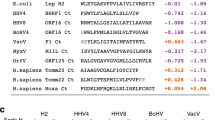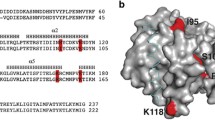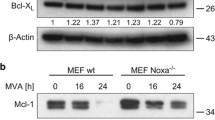Abstract
We have previously shown that the Orf virus protein, ORFV125, is a potent inhibitor of the mitochondrial pathway of apoptosis and displays rudimentary sequence similarities to cellular anti-apoptotic Bcl-2 proteins. Here we investigate the proposal that ORFV125 acts in a Bcl-2-like manner to inhibit apoptosis. We show that the viral protein interacted with a range of BH3-only proteins (Bik, Puma, DP5, Noxa and all 3 isoforms of Bim) and neutralized their pro-apoptotic activity. In addition, ORFV125 bound to the active, but not the inactive, form of Bax, and reduced the formation of Bax dimers. Mutation of specific amino acids in ORFV125 that are conserved and functionally important in mammalian Bcl-2 family proteins led to loss of both binding and inhibitory functions. We conclude that ORFV125’s mechanism of action is Bcl-2-like and propose that the viral protein’s combined ability to bind to a range of BH3-only proteins as well as the active form of Bax provides significant protection against apoptosis. Furthermore, we demonstrate that the binding profile of ORFV125 is distinct to that of other poxviral Bcl-2-like proteins.






Similar content being viewed by others
Abbreviations
- Bcl-2:
-
B-cell leukemia/lymphoma 2
- BH:
-
Bcl-2 homology
- ORFV:
-
Orf virus
References
Youle RJ, Strasser A (2008) The BCL-2 protein family: opposing activities that mediate cell death. Nat Rev Mol Cell Biol 9:47–59
Griffiths GJ, Dubrez L, Morgan CP et al (1999) Cell damage-induced conformational changes of the pro-apoptotic protein Bak in vivo precede the onset of apoptosis. J Cell Biol 144:903–914
Er E, Oliver L, Cartron PF, Juin P, Manon S, Vallette FM (2006) Mitochondria as the target of the pro-apoptotic protein Bax. Biochim Biophys Acta 1757:1301–1311
Adams JM, Cory S (2007) Bcl-2-regulated apoptosis: mechanism and therapeutic potential. Curr Opin Immunol 19:488–496
Chen L, Willis SN, Wei A et al (2005) Differential targeting of prosurvival Bcl-2 proteins by their BH3-only ligands allows complementary apoptotic function. Mol Cell 17:393–403
Willis SN, Fletcher JI, Kaufmann T et al (2007) Apoptosis initiated when BH3 ligands engage multiple Bcl-2 homologs, not Bax or Bak. Science 315:856–859
Letai A, Bassik MC, Walensky LD, Sorcinelli MD, Weiler S, Korsmeyer SJ (2002) Distinct BH3 domains either sensitize or activate mitochondrial apoptosis, serving as prototype cancer therapeutics. Cancer Cell 2:183–192
Kim H, Rafiuddin-Shah M, Tu HC et al (2006) Hierarchical regulation of mitochondrion-dependent apoptosis by BCL-2 subfamilies. Nat Cell Biol 8:1348–1358
Sattler M, Liang H, Nettesheim D et al (1997) Structure of Bcl-xL-Bak peptide complex: recognition between regulators of apoptosis. Science 275:983–986
Denisov AY, Chen G, Sprules T, Moldoveanu T, Beauparlant P, Gehring K (2006) Structural model of the BCL-w-BID peptide complex and its interactions with phospholipid micelles. Biochemistry 45:2250–2256
Czabotar PE, Lee EF, van Delft MF et al (2007) Structural insights into the degradation of Mcl-1 induced by BH3 domains. Proc Natl Acad Sci USA 104:6217–6222
Yin XM, Oltvai ZN, Korsmeyer SJ (1994) BH1 and BH2 domains of Bcl-2 are required for inhibition of apoptosis and heterodimerization with Bax. Nature 369:321–323
Cheng EH, Levine B, Boise LH, Thompson CB, Hardwick JM (1996) Bax-independent inhibition of apoptosis by Bcl-XL. Nature 379:554–556
Oda E, Ohki R, Murasawa H et al (2000) Noxa, a BH3-only member of the Bcl-2 family and candidate mediator of p53-induced apoptosis. Science 288:1053–1058
Zha J, Harada H, Osipov K, Jockel J, Waksman G, Korsmeyer SJ (1997) BH3 domain of BAD is required for heterodimerization with BCL-XL and pro-apoptotic activity. J Biol Chem 272:24101–24104
Wang K, Gross A, Waksman G, Korsmeyer SJ (1998) Mutagenesis of the BH3 domain of BAX identifies residues critical for dimerization and killing. Mol Cell Biol 18:6083–6089
Cuconati A, White E (2002) Viral homologs of BCL-2: role of apoptosis in the regulation of virus infection. Genes Dev 16:2465–2478
Galluzzi L, Brenner C, Morselli E, Touat Z, Kroemer G (2008) Viral control of mitochondrial apoptosis. PLoS Pathog 4:e1000018
Afonso CL, Tulman ER, Lu Z, Zsak L, Kutish GF, Rock DL (2000) The genome of fowlpox virus. J Virol 74:3815–3831
Wasilenko ST, Stewart TL, Meyers AF, Barry M (2003) Vaccinia virus encodes a previously uncharacterized mitochondrial-associated inhibitor of apoptosis. Proc Natl Acad Sci USA 100:14345–14350
Aoyagi M, Zhai D, Jin C et al (2007) Vaccinia virus N1L protein resembles a B cell lymphoma-2 (Bcl-2) family protein. Protein Sci 16:118–124
Cooray S, Bahar MW, Abrescia NG et al (2007) Functional and structural studies of the vaccinia virus virulence factor N1 reveal a Bcl-2-like anti-apoptotic protein. J Gen Virol 88:1656–1666
Everett H, Barry M, Lee SF et al (2000) M11L: a novel mitochondria-localized protein of myxoma virus that blocks apoptosis of infected leukocytes. J Exp Med 191:1487–1498
Westphal D, Ledgerwood EC, Hibma MH, Fleming SB, Whelan EM, Mercer AA (2007) A novel Bcl-2-like inhibitor of apoptosis is encoded by the parapoxvirus ORF virus. J Virol 81:7178–7188
O’Reilly LA, Huang DC, Strasser A (1996) The cell death inhibitor Bcl-2 and its homologues influence control of cell cycle entry. EMBO J 15:6979–6990
Huang DC, Cory S, Strasser A (1997) Bcl-2, Bcl-XL and adenovirus protein E1B19kD are functionally equivalent in their ability to inhibit cell death. Oncogene 14:405–414
Moriishi K, Huang DC, Cory S, Adams JM (1999) Bcl-2 family members do not inhibit apoptosis by binding the caspase activator Apaf-1. Proc Natl Acad Sci USA 96:9683–9688
Konagurthu AS, Whisstock JC, Stuckey PJ, Lesk AM (2006) MUSTANG: a multiple structural alignment algorithm. Proteins 64:559–574
Soding J (2005) Protein homology detection by HMM-HMM comparison. Bioinformatics 21:951–960
Hinds MG, Smits C, Fredericks-Short R et al (2007) Bim, Bad and Bmf: intrinsically unstructured BH3-only proteins that undergo a localized conformational change upon binding to prosurvival Bcl-2 targets. Cell Death Differ 14:128–136
Petros AM, Olejniczak ET, Fesik SW (2004) Structural biology of the Bcl-2 family of proteins. Biochim Biophys Acta 1644:83–94
Willis SN, Chen L, Dewson G et al (2005) Proapoptotic Bak is sequestered by Mcl-1 and Bcl-xL, but not Bcl-2, until displaced by BH3-only proteins. Genes Dev 19:1294–1305
Subramanian T, Vijayalingam S, Lomonosova E, Zhao LJ, Chinnadurai G (2007) Evidence for involvement of BH3-only proapoptotic members in adenovirus-induced apoptosis. J Virol 81:10486–10495
Sun Y, Leaman DW (2005) Involvement of Noxa in cellular apoptotic responses to interferon, double-stranded RNA, and virus infection. J Biol Chem 280:15561–15568
Belov GA, Romanova LI, Tolskaya EA, Kolesnikova MS, Lazebnik YA, Agol VI (2003) The major apoptotic pathway activated and suppressed by poliovirus. J Virol 77:45–56
Fleming SB, McCaughan CA, Andrews AE, Nash AD, Mercer AA (1997) A homolog of interleukin-10 is encoded by the poxvirus orf virus. J Virol 71:4857–4861
Becherel PA, LeGoff L, Frances C et al (1997) Induction of IL-10 synthesis by human keratinocytes through CD23 ligation: a cyclic adenosine 3′,5′-monophosphate-dependent mechanism. J Immunol 159:5761–5765
Perez D, White E (2000) TNF-alpha signals apoptosis through a bid-dependent conformational change in Bax that is inhibited by E1B 19K. Mol Cell 6:53–63
Zhai D, Jin C, Huang Z, Satterthwait AC, Reed JC (2008) Differential regulation of Bax and Bak by anti-apoptotic Bcl-2-family proteins, Bcl-B and Mcl-1. J Biol Chem 283:9580–9586
Kulms D, Zeise E, Poppelmann B, Schwarz T (2002) DNA damage, death receptor activation and reactive oxygen species contribute to ultraviolet radiation-induced apoptosis in an essential and independent way. Oncogene 21:5844–5851
Douglas AE, Corbett KD, Berger JM, McFadden G, Handel TM (2007) Structure of M11L: a myxoma virus structural homolog of the apoptosis inhibitor, Bcl-2. Protein Sci 16:695–703
Kvansakul M, van Delft MF, Lee EF et al (2007) A structural viral mimic of prosurvival Bcl-2: a pivotal role for sequestering proapoptotic Bax and Bak. Mol Cell 25:933–942
Kvansakul M, Yang H, Fairlie WD et al (2008) Vaccinia virus anti-apoptotic F1L is a novel Bcl-2-like domain-swapped dimer that binds a highly selective subset of BH3-containing death ligands. Cell Death Differ 15:1564–1571
Banadyga L, Gerig J, Stewart T, Barry M (2007) Fowlpox virus encodes a Bcl-2 homologue that protects cells from apoptotic death through interaction with the proapoptotic protein Bak. J Virol 81:11032–11045
Wang G, Barrett JW, Nazarian SH et al (2004) Myxoma virus M11L prevents apoptosis through constitutive interaction with Bak. J Virol 78:7097–7111
Su J, Wang G, Barrett JW, Irvine TS, Gao X, McFadden G (2006) Myxoma virus M11L blocks apoptosis through inhibition of conformational activation of Bax at the mitochondria. J Virol 80:1140–1151
Wasilenko ST, Banadyga L, Bond D, Barry M (2005) The vaccinia virus F1L protein interacts with the proapoptotic protein Bak and inhibits Bak activation. J Virol 79:14031–14043
Banadyga L, Veugelers K, Campbell S, Barry M (2009) The fowlpox virus BCL-2 homologue, FPV039, interacts with activated Bax and a discrete subset of BH3-only proteins to inhibit apoptosis. J Virol 83:7085–7098
Taylor JM, Barry M (2006) Near death experiences: poxvirus regulation of apoptotic death. Virology 344:139–150
Taylor JM, Quilty D, Banadyga L, Barry M (2006) The vaccinia virus protein F1L interacts with Bim and inhibits activation of the pro-apoptotic protein Bax. J Biol Chem 281:39728–39739
Acknowledgments
This work was supported by the Health Research Council of New Zealand and the University of Otago. We wish to thank David Huang and Jamie Fletcher (The Walter and Eliza Hall Institute of Medical Research (WEHI), Australia) for providing information and a range of plasmids expressing Bcl-2 family members. We are grateful to Jerry Adams (WEHI, Australia) for critical reading of the manuscript, Catherine Day and Fabienne Lecomte (University of Otago, New Zealand) for helpful discussions and Ellena Whelan (University of Otago) for technical support.
Author information
Authors and Affiliations
Corresponding author
Additional information
Elizabeth C. Ledgerwood and Andrew A. Mercer contributed equally to this work.
Electronic supplementary material
Below is the link to the electronic supplementary material.
Rights and permissions
About this article
Cite this article
Westphal, D., Ledgerwood, E.C., Tyndall, J.D.A. et al. The orf virus inhibitor of apoptosis functions in a Bcl-2-like manner, binding and neutralizing a set of BH3-only proteins and active Bax. Apoptosis 14, 1317–1330 (2009). https://doi.org/10.1007/s10495-009-0403-1
Published:
Issue Date:
DOI: https://doi.org/10.1007/s10495-009-0403-1




